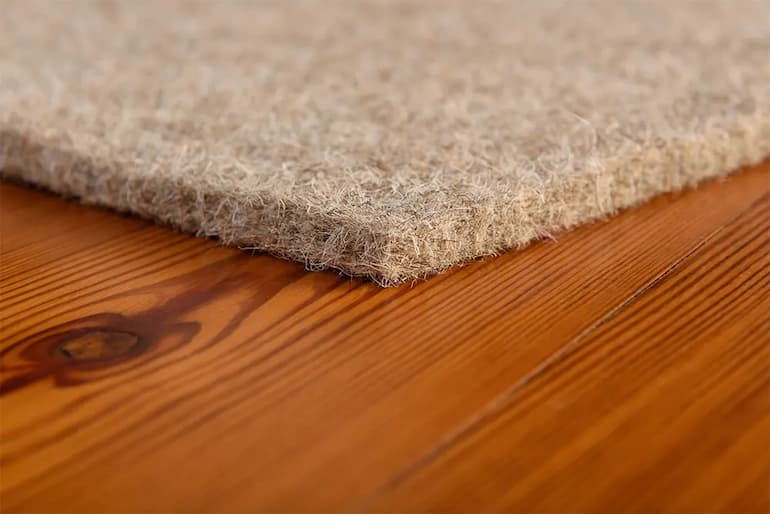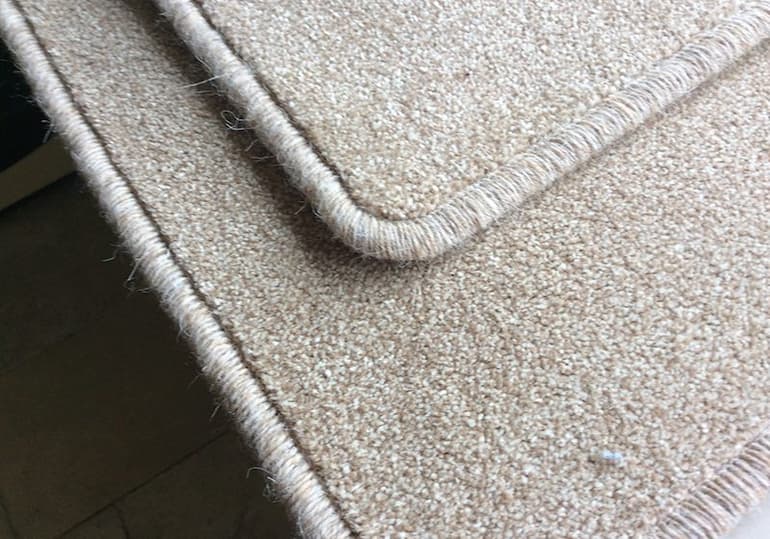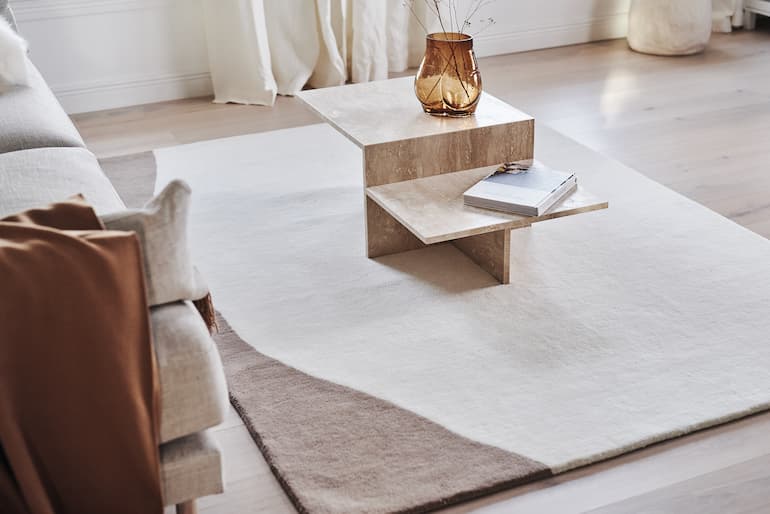Wool carpets have been known for their high quality and resilience for hundreds of years. They are still a popular carpet choice for homeowners but also in the construction and hospitality industries because they’re practically synonymous with luxury.
Wool is a strong fibre with a lovely aesthetic and excellent appearance retention qualities. When maintained properly, it’s also incredibly durable, making it a worthy investment when it comes time to replace old carpets or buy new ones. To truly understand whether the wool carpet is the best option for your home, let’s examine the various types of wool carpets and the advantages and disadvantages of this versatile flooring choice.
Types of Wool Carpets
Generally speaking, there are two types of wool carpets: 100% wool carpets and 80/20 wool mix carpets. According to the location and intended usage of the carpets, both blends can be created as carpet tiles or in broadloom style, giving installation options.
100% Wool Carpets

Since humanity first learned how to shear soft, fluffy wool from sheep herds, humans have used it for floor coverings; that’s been happening for hundreds, if not thousands, of years. 100% wool carpet, often known as natural wool carpet, refers to those made entirely of this material.
“String” wool is the ideal type of wool for making 100% wool carpets. Many carpets contain British and New Zealand wool found on sheep breeds in Britain and New Zealand.
New Zealand wool is much softer and whiter than British wool, which makes it the ideal fabric for neutral or lighter shade ranges. British wool is dense, robust, and has a distinctive texture. Most people consider Merino wool from New Zealand the more high-quality option, but wool from other sheep breeds worldwide can be just as good and frequently have distinctive qualities.
Other natural carpet alternatives come from llamas, alpacas, goats, camels, and other animals’ wool with comparable hairy coats in addition to sheep wool.
80/20 Wool Carpet

Wool carpet has intrinsic strength, so adding fibres isn’t crucial for resilience. Yet, in some situations and for specific purposes, it’s frequently blended with other fibres, typically synthetic ones. 80/20 wool carpets, also known as wool mix carpets or wool blend carpets, are the name given to these hybrids.
Manufacturers employ synthetic components in the yarn for various reasons, including increasing fibre flexibility, stain resistance, and durability and simplifying dyeing and printing.
Is 100 Wool Better Than Wool Blend?
A 100% wool carpet is generally warmer and more insulating than wool blend carpets. Frequently combined with natural materials like cotton and silk or synthetic fabrics like nylon and polyester, wool blends with a higher wool component (at least 60%) have better insulating qualities.
These textiles may help soften garments and cut costs, but they aren’t frequently much insulating as natural wool. If you opt for a luxurious feel, comfort, and the functionality natural wool insulation brings, go for a 100% wool carpet.
Advantages of Wool Carpets

Wool carpets have massive benefits, whether you’re thinking about a 100% natural wool carpet or an 80/20 wool blend. Here are some of them.
Strength and Durability
Wool offers exceptional performance because of its long-lasting toughness, inherent crimp, strength, and elasticity, which allows it to create a “bounce-back” and results in substantially less pile compaction, tracking markings, and shadowing. Because of all that, wool carpets can preserve their excellent looks for many years, if not decades.
Soil and Dirt Resistance
Wool is a completely natural fibre that also includes natural oils. These oils are resistant to dirt and will repel another oil-based soiling. Additionally, as wool is an opaque fibre, stains won’t be as easy to spot, giving your carpet a naturally clean appearance. Most of the time, regular vacuuming will be sufficient to maintain your carpet’s aesthetic quality.
Comfort and Cosiness
Nothing is cosier and more opulent than a wool carpet’s warmth and comfort. During the chilly winter months, the wool is an insulator to keep your home warm, making it an energy-efficient investment. It’ll also absorb sound, protecting the house from echoes and noise.
Fire Resistant and Inflammable
Wool has a slow rate of ignition and is naturally fire-resistant. As a result, wool models are exceptionally safe to use on top of your home flooring or as part of your office decor. If a fire starts, the carpet fibres will melt rather than burn, which will slow down or even stop the fire.
Fall Compliant
Wool rugs’ inherent coil and softness provide a cushion, guarding against significant injuries from falls, making them perfect for nurseries or nursery homes (because small children and older people are more susceptible to falls). That’s improved even more when there’s a high-quality underlay, which can further guard against falls and offer other advantages.
Hypoallergenic
Wool’s tiny scales trap fine dust until you vacuum it, reducing the amount of floating particulate in the atmosphere. Then, before it may irritate the skin, a high-quality vacuum cleaner will remove dust and debris. Wool is also a naturally “smart” fibre that can assist a balanced environment in any home since it can collect humidity from the air and then dismiss it again when the environment becomes dry.
Organic and Sustainable

The wool comes from sheep or other animals that require regular shearing, an essential component of caring for these animals. As a result, the carpet business has access to a new supply of wool every year, making the fabric entirely natural and sustainable.
Biodegradable
Wool biodegrades in soil, releasing plant-nutrient-rich nitrogen, sulphur, carbon dioxide, and water as it breaks down. Because of this, 100% wool carpets are a terrific option for flooring if we want to preserve and protect the natural environment.
Disadvantages of Wool Carpets
Initial Price
The high cost of wool carpets results from the processing and creation of a more “luxury” product, as well as the cost to clean and maintain the product throughout its existence, even though wool is a cheap and plentiful material. This cost will balance out when compared to frequently replacing other carpets, though, since well-maintained wool carpets are likely to last far longer than other materials.
Absorbency
Wool carpets are very absorbent, and while this quality can be beneficial for removing humidity from the air, it is less advantageous when it comes to spills or repeated contact with water, as might occur in or near a bathroom.
Chemical Resistance
Wool carpets can suffer damage from even brief exposure to alkaline substances with a pH higher than 9.5 unless thoroughly cleaned or neutralised. Strong chemicals essentially destroy your carpet by making the fibres stiff and lose their colour, starting to dissolve. Because of this, it might be challenging to locate an ordinary cleaning solution that can remove soiling-related stains, though expert carpet cleaners should be able to suggest items with a neutral pH.
The Final Verdict
Wool is a traditional high-end carpet fibre with several unique characteristics that set it apart from other threads. It’s entirely all-natural, cosy, resilient to fire, long-lasting, and sustainable!
Although buying wool carpet will cost a little more and take a little more maintenance than other 100% synthetic alternatives, the benefits greatly exceed the additional expense.
Wool carpets should always meet or surpass expectations when specified, installed, and maintained properly, whether for a family home, a luxury hotel or any high-end commercial specification.

